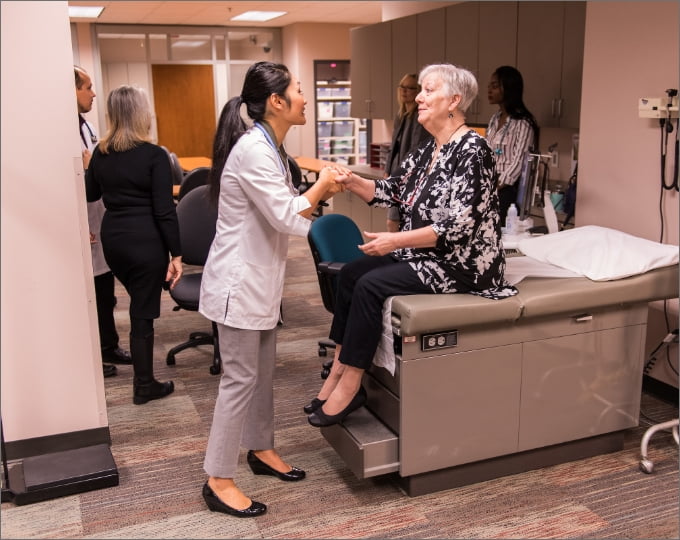
AGPCNP vs FNP: What's the Difference Between These Primary Care Nurse Practitioners?
January 5, 2022If you want to become a primary care nurse practitioner, you may be curious about which certification area to pursue.
Two of the most common are adult-gerontology primary care and family health. Nearly 8 in 10 nurse practitioners are certified adult-gerontology primary care nurse practitioners (AGPCNPs) or family nurse practitioners (FNPs).
But how do the AGPCNP and FNP roles compare? And which one aligns with your clinical interests and career aspirations?
You can use this blog to find out. Continue reading to learn how the roles differ in practice scope, job outlook, salary and more.
AGPCNP vs. FNP: What's the Difference?
AGPCNPs and FNPs are two types of primary care nurse practitioners. They are advanced practice registered nurses (APRNs) who hold a minimum of a master's degree in nursing focused on at least one patient population.

On a typical day, AGPCNPs and FNPs might:
- Diagnose and manage acute and chronic illnesses, diseases and conditions that fall under primary care.
- Obtain patient medical histories.
- Perform physical exams.
- Order, perform and interpret screening and diagnostic tests.
- Prescribe pharmacological and nonpharmacological therapies (depending on where they practice).
- Manage patient transition between care settings.
- Develop treatment plans.
- Provide patient and caregiver education.
There are similarities and differences when it comes to AGPCNP vs. FNP scope of practice. Both are prepared to deliver primary care, but each serves a unique patient population.
AGPCNP Scope of Practice
AGPCNPs are prepared to treat adolescents, adults and older adults—in other words, generally patients age 13 and over. The scope of practice focuses on assessing, diagnosing and managing acute and chronic conditions that are stable.
An adult gerontology-primary care certification can be appealing to aspiring primary care nurse practitioners who don't have a clinical interest in pediatrics. It's also ideal for those who are passionate about caring for older adults.
Most AGPCNPs practice in hospital outpatient clinics, hospital inpatient units and private group practice.

FNP Scope of Practice
FNPs are prepared to treat patients of all ages, from infants to older adults. They often see patients throughout their lives and treat entire families. If you want to work with individuals and families across the lifespan, a nurse practitioner certification in family health may best suit you.
FNPs provide a range of primary care services. Their practice focuses on health promotion, disease prevention and treating illnesses, conditions and injuries that fall under primary care.
Because FNPs serve patients of all ages, they can work in a variety of health care settings. The top FNP practice settings are hospital outpatient clinics, private group practices and private physician practices.
How Common Are Each Certification Area?
Adult-gerontology primary care and family health are among nurse practitioners' most common certification areas.
According to the American Association of Nurse Practitioners (AANP), more nurse practitioners are certified in family health than in any other area. Adult-gerontology primary care is the third most popular certification area.
Here is the distribution of nurse practitioners by primary certification area, with primary care certifications in bold:
- Family: 69.7%
- Adult: 10.8%
- Adult-Gerontology Primary Care: 7.0%
- Psychiatric/Mental Health: 4.7%
- Acute Care: 4.1%
- Pediatrics-Primary Care: 3.2%
- Adult-Gerontology Acute Care: 2.9%
- Women's Health: 2.9%
- Gerontology: 1.8%
- Neonatal: 1%
- Pediatrics - Acute Care: 0.7%

A Word About Adult-Gerontology Nurse Practitioner Certification
The list above includes two certification areas that are no longer available to new nurse practitioners: adult and gerontology. These certifications retired in 2015 and 2012, respectively, to meet the regulatory requirements of the APRN Consensus Model.
Today, there are two certification options for new nurse practitioners seeking adult-gerontology certification: adult-gerontology primary care and adult-gerontology acute care.
Like AGPCNPs, nurse practitioners certified in adult-gerontology acute care (AGACNPs) are prepared to treat patients ages 13 and over. However, their practice focuses on caring for patients with complex, acute conditions that require advanced intervention and critical care monitoring. AGACNPs often work non-traditional work hours in tertiary care settings.
What Are AGPCNP vs. FNP Job Outlooks?
As primary care nurse practitioners, AGPCNPs and FNPs have bright career outlooks. That's because the U.S. has a high demand for primary care providers. Nearly 84 million Americans live in areas with a shortage of primary care health professionals.
The high demand stems from a lack of primary care physicians. By 2034, the American Association of Medical Colleges (AAMC) estimates a shortage of between 17,800 and 48,000.
According to AAMC, the primary cause of the shortage is the growing aging population. Another factor is the number of physician retirements. Almost half of active U.S. physicians will be age 65 or over within the next decade.
Fortunately, AGPCNPs and FNPs can help fill the gap in primary care providers. Both nurse practitioners are prepared to deliver the full range of primary care services.
The high demand for primary care providers means that you can build a stable career as an AGPCNP or FNP.
The U.S. Bureau of Labor Statistics (BLS) reported that nurse practitioner employment will grow by 52% between 2020 and 2030. That makes nurse practitioner one of the fastest-growing jobs in the country.
BLS credits the growth to a greater emphasis on preventative care and higher demand for health care from the aging population. As preventive and primary care providers, AGPCNPs and FNPs stand to benefit from the projected nurse practitioner employment growth.

How Can AGPCNPs and FNPs Make a Difference?
Nurse practitioners are essential to U.S. health care. Evidence shows that nurse practitioners deliver high-quality, cost-effective and patient-centered care.
Because of their primary care preparation, AGPCNPs and FNPs can help solve some of the country's most pressing health care challenges. Let's explore two examples—meeting the health care needs of aging adults and rural populations.
Health Care Needs of Aging Adults
The population of aging Americans is growing fast. According to AAMC, the number of adults age 65 and over will increase by nearly 42% between 2019 and 2034.
With a looming shortage of primary care physicians, the country needs more primary care providers to meet the health care needs of older adults.
Data from the U.S. Centers for Disease Control (CDC) shows that older adults are more likely to have chronic health conditions, like heart disease and diabetes. Eighty percent have at least one chronic condition.
With specialized knowledge of adult health needs, AGPCNPs have the ideal preparation to improve health outcomes for aging Americans. They can treat health conditions that fall under primary care, prevent disease and promote optimal health through patient education.
Working in settings such as hospital outpatient clinics, nursing homes and assisted living facilities, AGPCNPs can make a meaningful difference in the lives of older adults.

Health Care Needs of Rural Populations
According to the CDC, rural Americans "tend to be older and sicker" than people living in urban areas. Rural populations have higher poverty rates, less access to health care and are less likely to have health insurance. As a result, they are at greater risk for poor health outcomes, including death from the five leading causes.
With 15% of Americans living in rural areas, the CDC has called on the U.S. to address these health care gaps. Fortunately, FNPs are prepared to help.
Because FNPs serve patients of all ages, they can expand primary care access across rural America. From patient education to disease prevention and treating serious illnesses, FNPs can improve health outcomes for people living in remote areas.
In some rural communities, a primary care nurse practitioner may be the only health care provider available. These solo practitioners will benefit from having a dual certification in adult-gerontology acute care, which enables them to provide the full scope of care.
How to Become an AGPCNP vs. FNP?
The process for becoming an AGPCNP and FNP are similar. You'll fulfill educational requirements, obtain national certification and then get state licensure where you plan to practice.
Step 1: Education
To become an AGPCNP or FNP, you must first become an RN with a minimum of a Bachelor of Science in Nursing. Then you should complete an accredited post-licensure graduate nursing program in the respective specialization area. Acceptable credentials are a Master of Science in Nursing, Doctor of Nursing Practice or Post-Master's Certificate.
The agencies that accredit U.S. nurse practitioner programs are the Accreditation Commission for Education in Nursing (ACEN) and the Commission on Collegiate Nursing Education (CCNE). They have accredited hundreds of institutions offering AGPCNP and FNP programs. Completing an accredited program is important because it is a requirement for sitting a national certification exam.
When it comes to the curricula, AGPCNP and FNP programs consist of coursework and clinical experiences. They will prepare you with advanced nursing competencies to serve the specific patient population. As part of your program, you will complete at least 500 direct patient care clinical hours.
AGPCNP and FNP programs take approximately two to four years to complete, depending on the degree granted.
Step 2: National Certification
Once you've completed an AGPCNP or FNP education program, you will apply for national certification through examination.
The American Nurses Credentialing Center (ANCC) and the American Association of Nurse Practitioners (AANP) grant nurse practitioner certification in the U.S. Both organizations offer AGPCNP and FNP certifications.
The certification process is similar for both roles. First, you'll complete an application to determine whether you're eligible. Once your application is approved, you'll take an exam.
The application for national certification usually requires:
- Proof of a current, unencumbered RN license.
- Proof of completion of an accredited AGPCNP or FNP education program and supervised clinical practice hours.
- A transcript showing academic coursework completed.
- An application fee.
AGPCNP vs. FNP exam content differs by the certification body. Overall, it will test your clinical knowledge of your population area.
National nurse practitioner certification is valid for five years. Then, you'll need to renew yours following the process outlined by ANCC or AANP.
Step 3: State Licensure
Nurse practitioners must be licensed by the state where they practice. The licensure process works differently in every state. In most cases, you will need to apply for licensure through the state board of nursing.
The application for state licensure usually requires:
- Proof of a current, unencumbered RN license.
- Proof of national AGPCNP or FNP certification.
- Proof of completion of an accredited AGPCNP or FNP education program and supervised clinical practice hours.
- An application fee.
Once you obtain state licensure, you can seek employment. Licensed AGPCNPs and FNPs must renew their nurse practitioner and RN credentials according to the timeline and requirements set forth by the state board of nursing.

AGPCNP vs. FNP Salary
AGPCNPs and FNPs have similar earning potential. According to the 2020 National Nurse Practitioner Sample Survey, full-time AGPCNPs have a total median income of $116,000. Full-time FNPs take home $115,000. These figures include base salary, productivity bonuses and incentive payments.
Aside from the certification area, other factors will affect your nurse practitioner salary.
One is practice setting. Depending on where you work, you may earn more or less than the median salary.
Here are the median total incomes of full-time nurse practitioners working in the most common practice settings of AGPCNPs and FNPs:
- Hospital Outpatient Clinic: $117,000
- Private Group Practice: $115,000
- Private Physician Practice: $110,000
- Hospital Inpatient Unit: $125,000
Another factor is the state where you practice. Some states pay significantly higher nurse practitioner salaries than others.
The average salaries in the top five-paying states are:
- California: $145,970
- New Jersey: $130,890
- Washington: $126,480
- New York: $126,440
- Massachusetts: $126,050
Learn more about nurse practitioner salary.

Prepare to Make a Difference as a Primary Care Nurse Practitioner
Primary care nurse practitioners have a rewarding career path. AGPCNPs and FNPs can improve patient outcomes by delivering vital primary care while enjoying tremendous employment opportunities and solid earning potential.
So which role is right for you?
Becoming an AGPCNP will let you specialize in adult primary care and address growing health care needs in the aging population. If you want the flexibility to treat patients of all ages, becoming an FNP may be ideal.
Are you ready to start your career as an AGPCNP or FNP? Texas Woman's University can help you take the first step. Texas Woman's offers accredited Master of Science in Nursing programs for aspiring AGPCNPs and FNPs.
The accredited online Master of Science in Nursing - Family Nurse Practitioner (MSN-FNP) will prepare you to meet the nation's growing need for primary care nurse practitioners. You will develop the advanced clinical expertise, critical thinking and clinical reasoning to lead and innovate primary care delivery.
Learn more about TWU's online MSN-FNP degree program.
If you're interested in becoming an AGPCNP, Texas Woman's offers a Master of Science in Nursing - Adult-Gerontology Primary Care Nurse Practitioner (MSN-AGPCNP) program on our campuses in Dallas and Houston, Texas. It will prepare you to assess, diagnose and manage the health of adults.
Learn more about TWU's MSN-AGPCNP program.
Both programs provide recognized academic excellence and a transformative student experience emphasizing whole-person care and health care innovation. Texas Woman's is CCNE-accredited and one of the top nursing schools in the country.
If you want to make a difference as a primary care nurse practitioner, you can prepare to deliver quality health care that supports the entire patient experience at Texas Woman's University.

